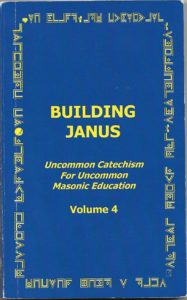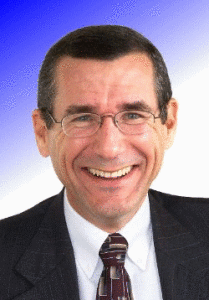 Building Janus is another catechism primer from Coach John Nagy. Building Janus is where the Master Mason builds insight. Nagy tells us that, “in Roman Mythology, Janus is the god of Bourne, Passages and the rising and setting Sum. In general, he was the patron of all beginnings, concrete and abstract.”
Building Janus is another catechism primer from Coach John Nagy. Building Janus is where the Master Mason builds insight. Nagy tells us that, “in Roman Mythology, Janus is the god of Bourne, Passages and the rising and setting Sum. In general, he was the patron of all beginnings, concrete and abstract.”
What does the Third Degree do for Masons? Well, Nagy tells us that it directs Masons into “learning how to learn.” He says that it “assists them in recognizing things that most ordinary thinkers would not.” “Men are prepared to see things that unprepared men cannot.”
Nagy speaks about the Bourne, the passage, and how Masonic study opens doors. “Masters (Master Masons) perceive Doors unseen by others, “he says. He goes on to say, “Masters open Doors locked to others. Masters Pass through Doors impassable by others.”
But to make this journey, to travel in foreign lands, to experience new ideas, a Master Mason must prepare himself for travel. “Improperly prepared Masons venturing into such lands are likened to individual hands making effort to clap against nothing.”
Nagy explains to us the eight foreign lands a Mason is introduced to. To make these journeys a Master Mason needs to “pay attention to the ritual and do the Work required of him.”…for those who are Properly Prepared and who possess suitable proficiency, Traveling never ends.”
From there Nagy tells us, “The working Tool that is my favorite is the one that exists within a truly Raised Mason. That Working Tool is his Ordered brain.” Nagy speaks strongly here about bringing men to Order from Chaos. He tells us of the benefits of the three degrees:
- “Masons trained by Entered Apprentice Work are less likely to strike out personally at other people when it is pointed out that the quality of their work lacks Integrity.”
- “Masons trained by Fellow Craft Work are less likely to accept the illogical, irrational and unsound premises and conclusions that lesser trained people offer up as credible.”
- “Fully trained Masons recognize specific Patterns that denote others who have been brought to Order from Chaos. They also recognize those people who are still in Chaos.”
Coach Nagy is a very spiritual man. He shows us that in his Ordering Catechism.
“The second task is understanding how both the internal and the external worlds interrelate. The foundation of this understanding is also laid by doing the Work spoken of in the first two degrees.”
“How do Masons benefit from this knowledge? They accurately perceive the interconnections of both worlds and between both worlds.”
“The third task is to apply these understanding Metaphorically toward worlds conceived by imagination that lie beyond those known by humankind’s physical experience. Such ability allows Masons to obtain and communicate deep and profound truths with others who are likeminded.”
Now that is most profound.
But, “Ritual provides to Masons only the barest of bones. What is received by one’s efforts is only the beginning of Mastery.”
More Work is required, says Nagy. What follows in the book is explanations of The Widow’s Son and The Master’s Word.
Nagy tells us, “The more I explore the Allusions offered by Masonry, the more expansive and interconnected I find my world.”
A most interesting chapter is the one on the symbolism of the Lion in Masonry. And again Nagy urges his reader to pause and meditate on the meaning of such symbolism.
“Masons pausing to Perpend what is before them have an advantage over those Masons that don’t. It takes a certain amount of discipline to remove oneself from the game and reflect upon its different aspects. Insight into any game often depends upon Perpending elements not considered by those who do not take the time to pause.”
The history of the symbolism of the Lion in society through the ages is most interesting and reflects on why Masonry has included it in its ritual.
Nagy points out, “During the Greek and Roman period, the Lion was the Symbol of the fallen hero. It also was often used as a guardian figurine for Gates, Temples, and Buildings. In Christian art, the Lion represents the Redeemer. The Lion is also Emblematic of the Gospel writer Saint Mark the Evangelist. The Lion symbol was also used in medieval heraldry and is still currently used on seals, flags, shields and banners and is also depicted on the flag of Jerusalem.”
The fallen hero, eh? Now refer to the Legend of Hiram Abiff! How do we raise the fallen hero?
Nagy goes on to further catalog the use of the Lion during the Lion period in the 1700’s. “During this time, British artisans and craftsmen took to carving Lions’ masks on the knees of cabriole legs and the arms of chairs and settees, and Lion’s paws on furniture feet. This was the same period when the ‘Lion’ was carved into the foot of the Third Degree.”
But Nagy isn’t through with the lion. He points out the popularity of Sphinxes in ancient Egypt. “In ancient Egypt, Sphinxes were placed at the entrances of Temples to guard the mysteries, by warning those who penetrate within, that they should conceal the knowledge of these mysteries from the uninitiated.”
This Lion symbolism goes a long way to explain the meaning of the strong grip of a Master Mason.
Nagy concludes his book with a chapter on Speculative Masonry and why the term Speculative may be a misnomer.
 I have to say that this is my favorite Building book by Coach Nagy so far. This is where the Master Mason gets down to the nitty-gritty. This is where our request for some meat is answered.
I have to say that this is my favorite Building book by Coach Nagy so far. This is where the Master Mason gets down to the nitty-gritty. This is where our request for some meat is answered.
Nagy reminds us that Masonic Ritual is just a road map. It is up to us to take the road map and explore all the ramifications and applications that can broaden our world and truly make us better persons. This is where true Mastery begins.
Once again Coach Nagy advises us to think, to contemplate, to explore and ask questions and seek answers. Building Janus is the GPS to new discoveries. But we, as Master Masons, must learn how to learn and do the Work necessary to obtain the prize – those deep and profound truths that enable us to travel to foreign and uncharted venues. This is the real secret or mystery of Masonry, and Building Janus is the book for every Master Mason to take on his journey.
You can order your copy of Building Janus at the link below:


“The Lion symbol…is also depicted on the flag of Israel.”? Uh…no, it isn’t.
OK you are 1/2 right: SEE:
The Lion of Judah — The lion became associated with the Jewish people when Jacob on his death bed referred to the tribe of Judah as “a lion’s whelp” (Genesis 49:9). It was adopted as the symbol of the tribe of Judah, and later, when that tribe came to dominate Jewish life, it was identified with the Jewish people as a whole. It is used on the flag of Jerusalem. The design of that flag is similar to the flag of Israel, with a white background and dark blue stripes. But a depiction of the Lion of Judah replaces the Star of David in the center. The lion is displayed against a golden background that represents the Western Wall or “Wailing Wall” as it is known in the Western world. The word above the emblem is the Hebrew rendering of Jerusalem. The olive branches on each side represent the desire for peace, bringing to mind the biblical command to “pray for the peace of Jerusalem” (Psalm 122:6).
Changed from flag of Israel to flag of Jerusalem. Thanks for your due diligence!
Thank you for the information and much respect to change in the ‘flag of Israel’ to the flag of Jerusalem, 95% of the world know that Jerusalem belongs to Palestine and the Palestinians, and I see you are very busy and we can’t be expected to know everything.
I wondered if I could ask you something, this information I need to know and I really cannot find anywhere, I have seen an item for sale at $90 which is a charm which is half a skeleton head and half man’s head, and believe it’s a replica of the head of Janus, it’s advertised as methodical Freemason but I cannot find the reason why and the seller doesn’t know either would you mind directing me to where I could find out this information please. Thank you. Karen.